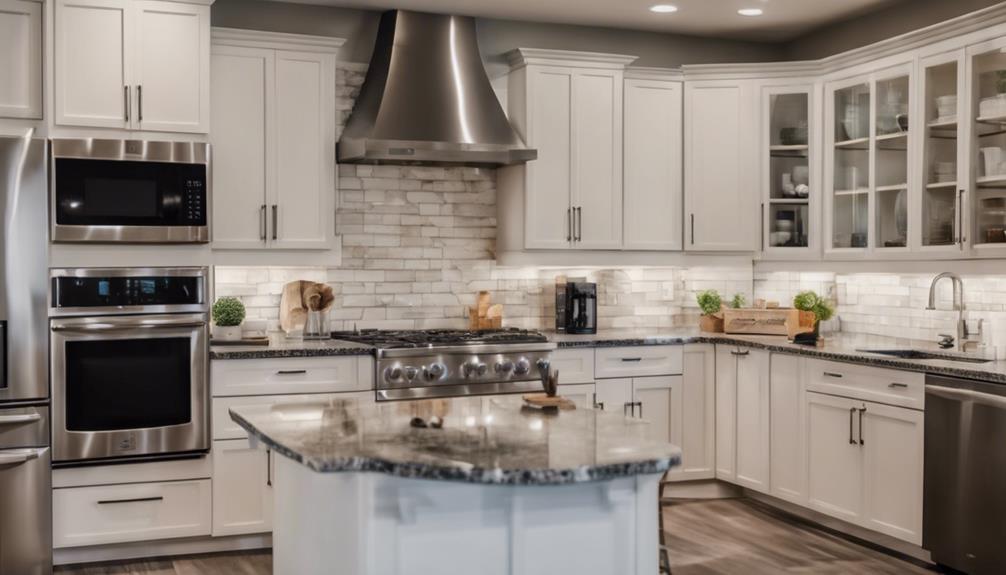Average Cost of a Kitchen Remodel

When embarking on a kitchen remodel, determining the average cost can feel like navigating a maze with twists and turns. As we explore the various factors that influence the overall expenses, from materials to labor, one can’t help but wonder: how much should we realistically set aside for such a project?
Join us on this journey through the realm of kitchen renovations as we uncover the average cost breakdowns, share cost-saving strategies, and shed light on regional cost disparities that may surprise you.
Factors Influencing Kitchen Remodel Costs
When planning a kitchen remodel, various factors can significantly impact the overall costs. We, as homeowners, understand the importance of creating a space that reflects our style and meets our needs.
One key factor that influences costs is the choice of materials. Opting for high-end materials such as granite countertops or custom cabinets can escalate expenses, while selecting more budget-friendly options like laminate countertops and stock cabinets can help keep costs in check.
Another factor to consider is the layout changes. Knocking down walls or relocating plumbing and electrical components will inevitably add to the total cost.
Additionally, the size of the kitchen plays a crucial role. A larger kitchen means more materials are required, leading to higher costs.
Finally, labor costs also impact the overall budget. Hiring experienced professionals and skilled contractors may increase expenses, but it ensures quality workmanship and a beautiful end result.
Average Cost Breakdown by Project Area
Considering the different project areas in a kitchen remodel, understanding the average cost breakdown helps in planning and budgeting effectively. The average cost breakdown by project area gives us a clear picture of where our budget will be allocated.
On average, cabinets and hardware can consume around 29% of the total budget. Countertops and backsplashes follow closely at 10%, while appliances and ventilation make up about 14% of the costs. Flooring and lighting usually account for 7% and 5%, respectively. Plumbing and electrical work typically amount to 4% each.
Design and installation services may take up the remaining 27%. Knowing these average percentages can guide us in making informed decisions about where to focus our budget based on our priorities. By understanding how costs are distributed across different project areas, we can tailor our remodel to suit our needs while staying within our budget constraints.
Cost-Saving Tips for Your Remodel
Looking to save money on your kitchen remodel without compromising on quality? We understand the importance of creating a space that feels just right while keeping costs in check. Here are some cost-saving tips to help you achieve your dream kitchen within your budget.
First, consider keeping the existing layout of your kitchen. By avoiding major structural changes, you can significantly cut down on costs associated with plumbing and electrical work. Reusing cabinets can also be a budget-friendly option. Instead of replacing them entirely, consider refinishing or repainting for a fresh look.
Another way to save money is by shopping for gently used or discounted materials. Many stores offer great deals on floor models or last season’s inventory, which can help you save big on items like appliances or fixtures. Additionally, consider doing some of the work yourself, such as painting walls or assembling furniture, to save on labor costs.
Regional Cost Differences to Consider
To better understand the cost variations in different regions, we analyze pricing factors that impact kitchen remodel expenses. When considering regional cost differences for your kitchen remodel, it’s crucial to recognize that labor and material prices can vary significantly based on your location. In urban areas, where demand is high, labor costs may be inflated compared to rural regions. Additionally, the cost of materials like cabinets, countertops, and flooring can also differ based on local availability and shipping expenses.
Factors such as the cost of living index and market competition play a significant role in determining regional price discrepancies. For instance, in bustling metropolitan areas, contractors may charge more due to higher overhead costs and increased competition for skilled labor. On the other hand, in less densely populated regions, where overhead expenses are lower, you might find more competitive pricing for similar services.
Understanding these regional cost differences can help you better budget for your kitchen remodel and avoid any surprises along the way. By researching and comparing prices in your specific area, you can make informed decisions that align with your financial expectations and project goals.
Budgeting for Unexpected Expenses
When planning for a kitchen remodel, it’s important to anticipate and budget for unexpected expenses that may arise during the project. We’ve all been there – what starts as a straightforward renovation can quickly become complicated by unforeseen issues. Setting aside a contingency fund of around 10-20% of your total budget can help cushion the impact of these surprises.
From hidden water damage to structural problems, having extra funds allocated for unexpected expenses can provide peace of mind and keep your project on track.
Additionally, it’s wise to work closely with your contractor to identify any potential trouble spots upfront. Experienced professionals can often foresee challenges that might arise and help you budget more accurately. Remember, it’s better to overestimate your costs and have money left over at the end of the project than to be caught off guard by unforeseen expenses.
Frequently Asked Questions
How Can I Maximize Storage Space in My Kitchen During a Remodel Without Significantly Increasing Costs?
To maximize storage space in a kitchen remodel without raising costs significantly, we recommend utilizing vertical space with tall cabinets, installing shelves above countertops, incorporating pull-out drawers, and choosing multi-functional furniture like kitchen islands with built-in storage.
Are There Any Eco-Friendly Options or Materials That Can Help Reduce Costs During a Kitchen Remodel?
Absolutely, there are eco-friendly options and materials that not only help the environment but also reduce costs during a kitchen remodel. We can explore options like reclaimed wood, energy-efficient appliances, and sustainable countertops.
What Are Some Innovative Design Ideas That Can Help Save Money on a Kitchen Remodel Without Compromising Style?
When it comes to saving money on a kitchen remodel without compromising style, we focus on clever layout adjustments, utilizing multifunctional elements, and opting for cost-effective materials that still deliver a sleek and modern aesthetic.
Are There Any Specific Appliances or Fixtures That Tend to Drive up Costs During a Kitchen Remodel, and How Can I Avoid Overspending on Them?
When renovating, we focus on high-cost items like premium appliances or custom fixtures. To avoid overspending, we research deals, buy during sales, consider gently used options, and prioritize quality over brand names.
How Can I Ensure That My Kitchen Remodel Stays Within Budget While Still Achieving the Desired Outcome?
To ensure our kitchen remodel stays within budget while achieving the desired outcome, we prioritize researching costs, setting a clear budget, obtaining multiple quotes, focusing on essential upgrades, and communicating openly with contractors to avoid surprises.
Conclusion
Overall, remodeling a kitchen can be a significant investment, but with careful planning and budgeting, it can also add value to your home and enhance your living space.
By considering the factors that influence costs, breaking down expenses by project area, implementing cost-saving tips, being aware of regional cost differences, and budgeting for unexpected expenses, you can achieve your desired kitchen remodel within a reasonable budget.
